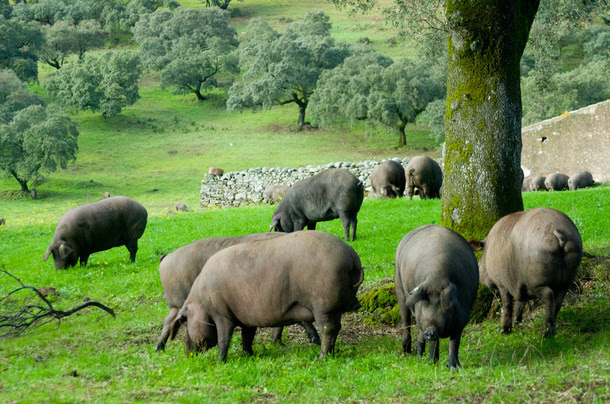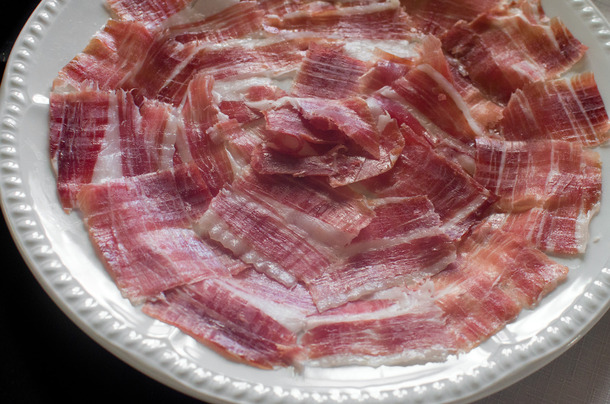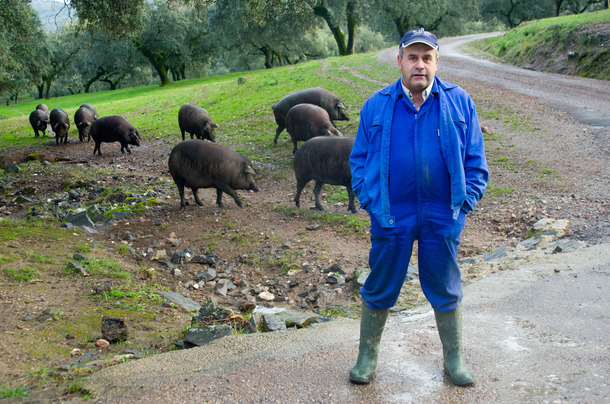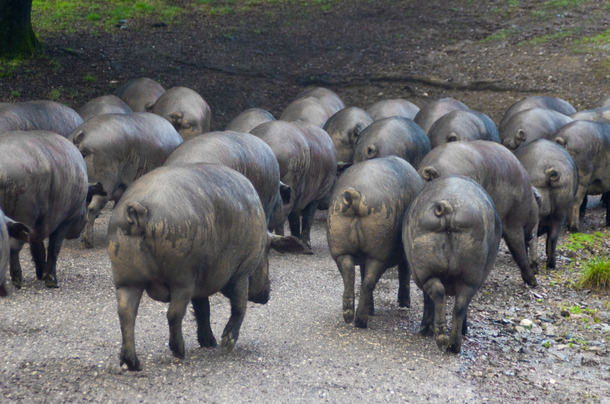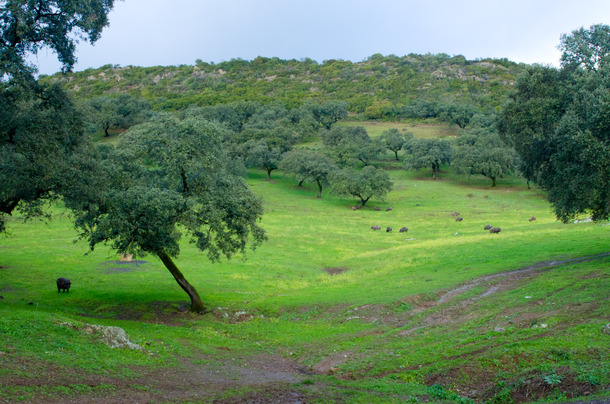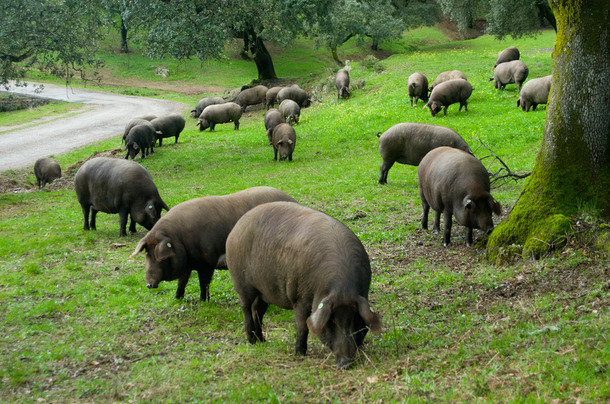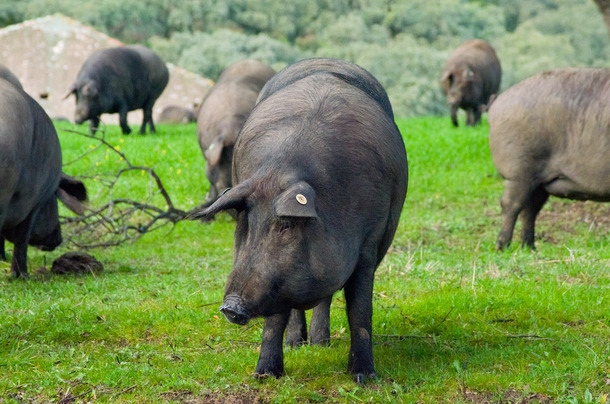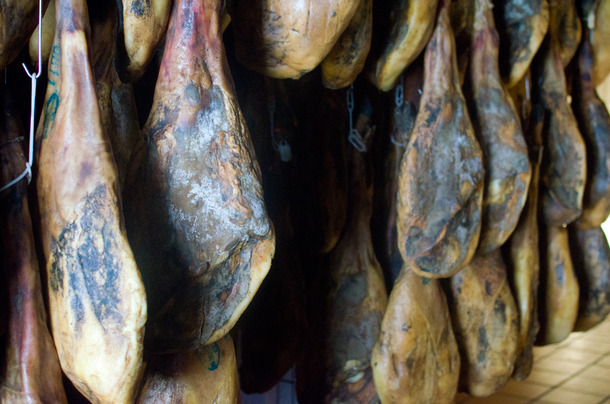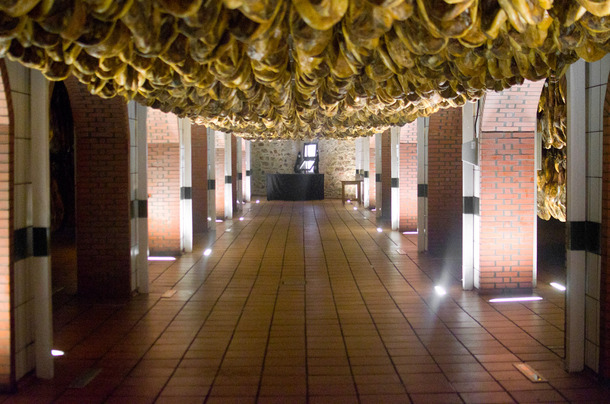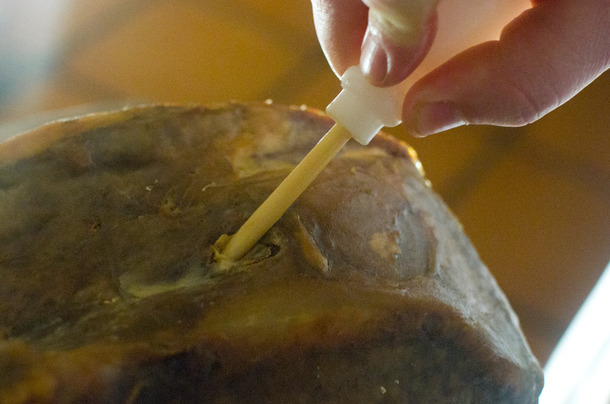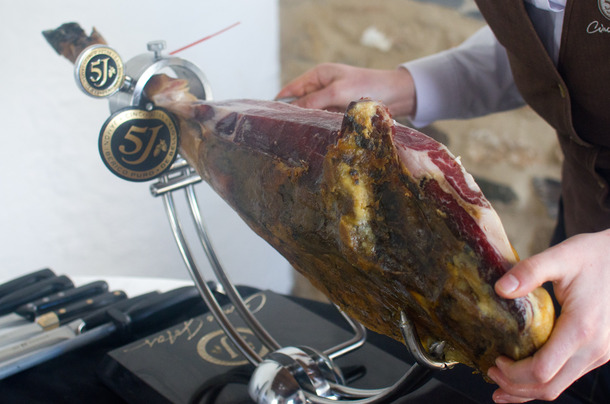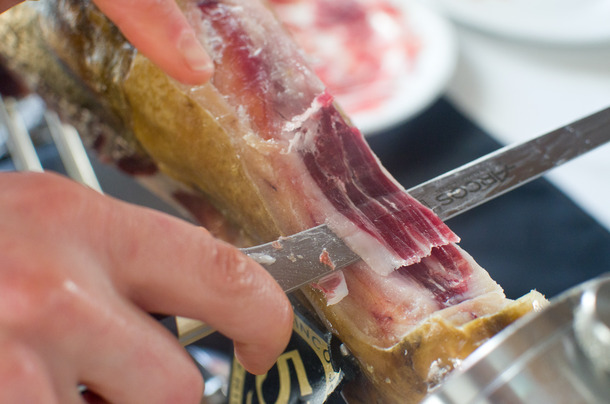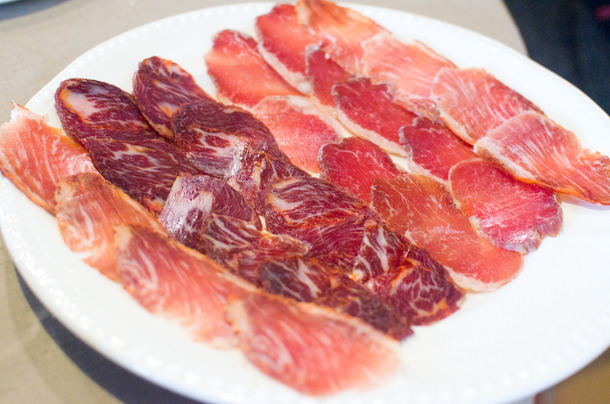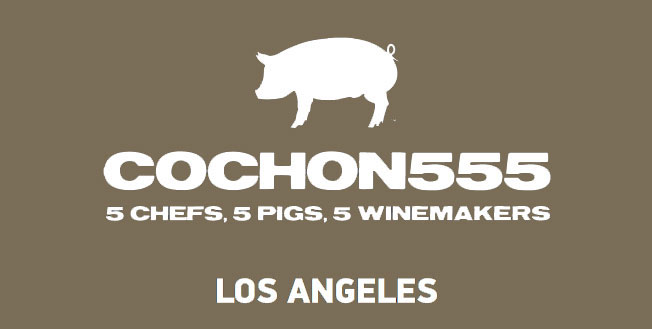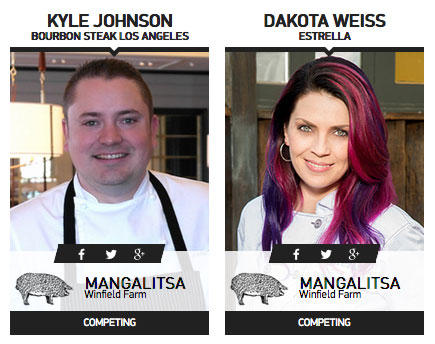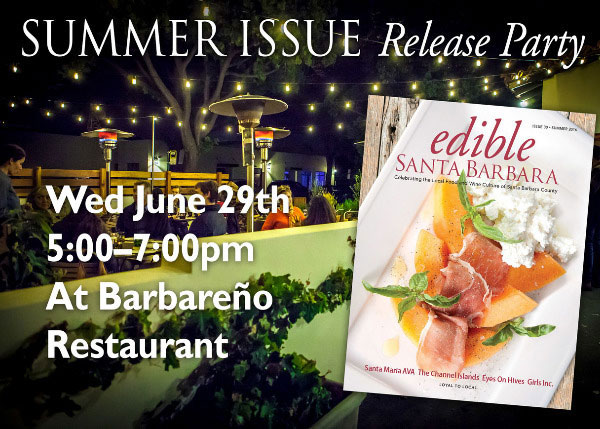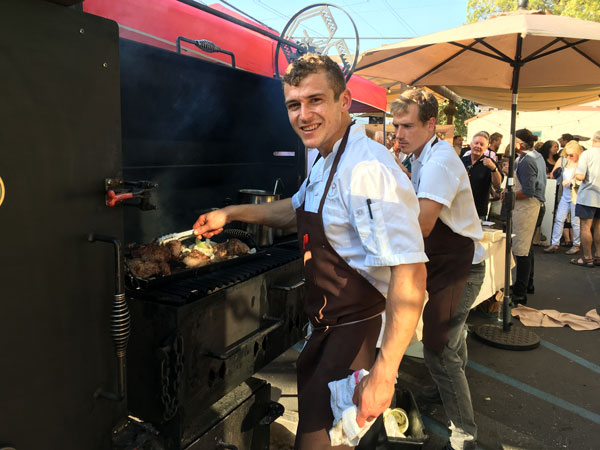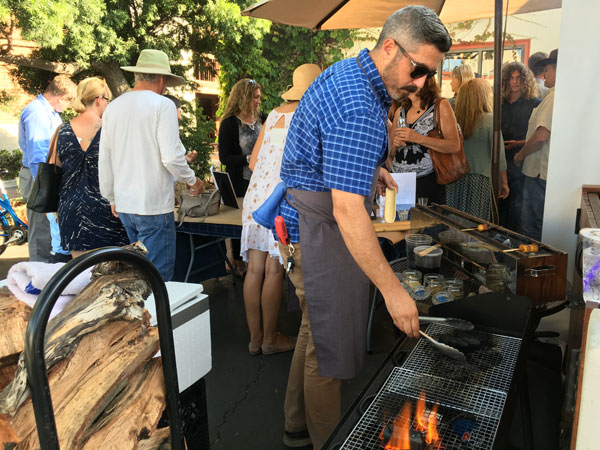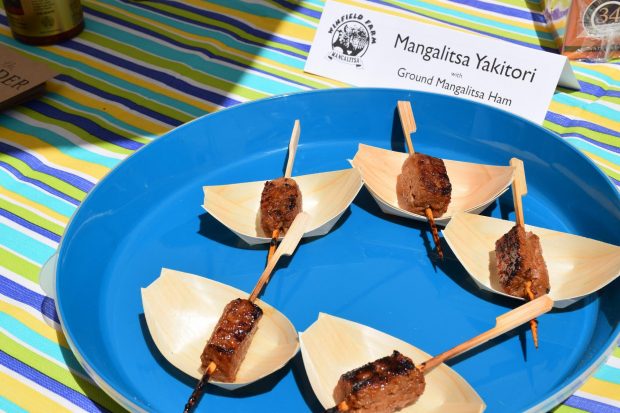Blog & News
History of the Mangalitsa

Many names are used for the Mangalitsa, his races and crossbreds: Mangalitsa, wool haired pig, curly-haired pig, Baris and Ordas (crossbred) or Bogauner (Bakony ancestor of Mangalitsa). In different countries are different spellings for Mangaltiza:
Mangalica (Hungarian), Mangulica (Serbian), Mangalita (rum), Mangalitsa (AmE), Mangulac, Mangaliza, Mangalicza. The races of the Mangalitsa pigs (Hungarian Blonde Mangalitsa) in Hungarian Szöke, Fecskehasu (Hungarian Mangalitsa swallowbellied) and Voros called (Hungarian Red Mangalitsa).
The primary breeding in Kisjeno has pioneered this development. A document from 1833 shows involved the transportation of twelve Schumadinka (Sumadija, Sumadia) fat pigs (2/10) as bred in Topscider, Belgrade, the Serbian Prince Milos Obrenovic, the Palatine of Hungary, Joseph Anton Johann of Austria in its Dömäne Kisjeno. This “Milos–pigs” were paired with Szalontai and Bakony–pigs. Their descendants became the basis for subsequent fat pig breeding. The “blood–Kisjeno” spread all over the numerous breeding flocks in Hungary.

Mangalitza as the leading lard type breed, the products of this pig fueled mainly the population of the Austro-Hungarian Empire. The reason of his popularity was the fat. After a long time runner, the pigs were fattened up to 250 to 300 kg,. 20 to 25cm backfat not uncommon.
Before the introduction of the Danube Steam Navigation and construction of rail shipments of pig farms they had to bring the pigs to the Vienna slaughterhouses in weeklong walks by feed. 1871, 38.330 fat pigs from Gyor and Sopron were driven to the Vienna market.
In the 1890s in Budpest a pig market system and the pig slaughter house was built. Hungarian livestock census in 1895 showed a population of 6,447,143 pigs (MATLEKOVITS 1900; Tormay 1896). 94% of them belonged to the lard type pig.
Hungary with 407 pigs per 1000 inhabitants, the country with the most pigs in Europe. 1894 73% to Central and Western Europe were exported.
This first golden age of Hungarian fat pig breeding ended in 1895 introduced from America, swine plague, export restrictions and rival, foreign pig meat breeds. The stock recovered only in 1911, but was again decimated in the war years.

From the 50s of the 20th Century, the demand for pork products changed radically and pig breeds with lean meat quality supplanted the Mangalitsa pig. During the late seventies industrial pig established with imported pig meat breeds and standardized health conditions in warehouses, the Mangalitsa pig was maintained only in zoos or occasionally by small farmers for their own use.
In 1973, the Mangalitsa in Hungary was placed under protection and introduced a subsidized gene reserve breed. Until 1980 within 10 farms it was possible to rebuilt a breeding line of the three race options: Blonde, Red and swallowbellied
Only an export agreement with Spain for the production of Serrano ham (Jamón Serrano) from 1990 caused an economic boom of Mangalitzas.
Originally posted: https://www.mangalitzainternational.org/
Mangalitsa Pork: Where to Buy and Try the Prized Meat
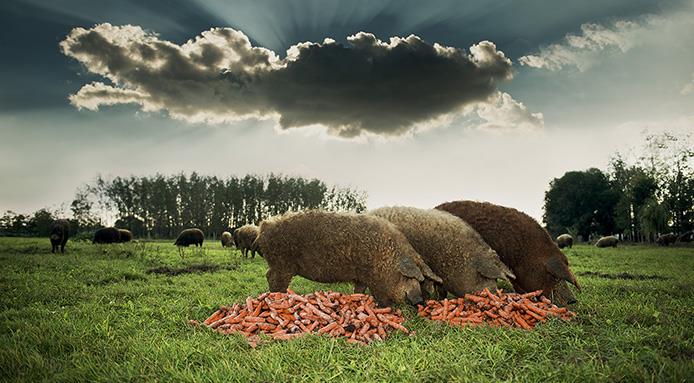
Known as Mangalica, Mangalitsa or Mangalitza, this is the pig prized for its high fat marbled meat that has been hailed as the Kobe beef of pork and attracted critical acclaim from chefs around the world.
As delicious as it is, tracking down this curly haired rare breed hog is still somewhat of a challenge, despite its growing popularity.
In response to the huge Facebook interest we had from our initial article introducing the delights of the succulent meat, we’ve decided to put together a list of some of the farms, shops and restaurants where you can get your hands on this tasty find.
From a rural farm in Wales to a three Michelin-starred restaurant in New York find out where you can try this tasty delicacy and you’ll be hooked.
Meanwhile, those wanting to go the whole hog should mark the annual Mangalica Festival Budapest in their diary for three days of celebrations from 10 to 12 February 2017 (TBC) and anything and everything related to Mangalitsa.
Watch the video from the Mangalica Festival 2012 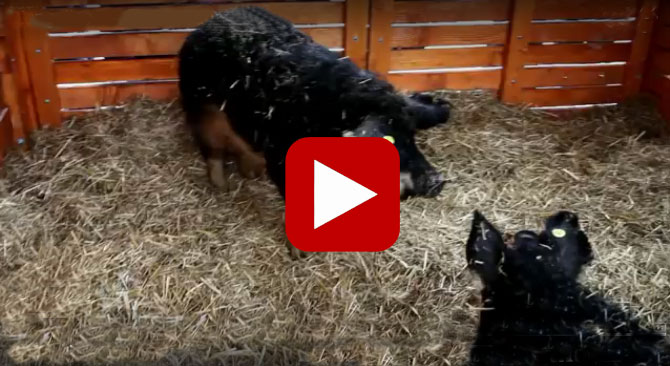
Originally published: https://www.finedininglovers.com/blog/culinary-stops/mangalista-pork/
Inside the Secret World of Super-Premium Spanish Jamon Iberico
Preface — Mangalitsa pigs (like the rare Hungarian breed raised at Winfield Farm) are the only other pigs besides Iberico that can officially be labeled “pata negra”. In fact, Spanish charcutiers rediscovered Mangalitsas in Hungary in the early 1990s while looking for new sources of premium quality lard hogs and found Mangalitsa, and their interest saved the breed from extinction. Mangalitsas also are descended from European boar lines.
[Photographs: Max Falkowitz]
It’s a misty Wednesday afternoon and the pigs are hard at work. So is their porquero Juan Carlo, who’s busy guiding them across this 1,700 acre farm to the land’s choicest acorns. At sunrise, Juan Carlo rouses about 340 pigs from their farmhouse and sets them to work. At sundown he corrals them back to the ranch. This year marks his 25th on the job.
In a few weeks the pigs’ work will be done: they’ll be sufficiently fattened up from their grazing to be slaughtered, butchered, and turned into some of the most expensive ham in the world—at my local source, $220 for a hand-sliced pound. Why so much? Because it’ll be jamon Iberico puro de bellota, acorn-fed pure breed Iberico ham, and sold under the Cinco Jotas (5J) brand, one of the oldest and most well-respected in Spain.
It’s a misty Wednesday afternoon and the pigs are hard at work. So is their porquero Juan Carlo, who’s busy guiding them across this 1,700 acre farm to the land’s choicest acorns. At sunrise, Juan Carlo rouses about 340 pigs from their farmhouse and sets them to work. At sundown he corrals them back to the ranch. This year marks his 25th on the job.
In a few weeks the pigs’ work will be done: they’ll be sufficiently fattened up from their grazing to be slaughtered, butchered, and turned into some of the most expensive ham in the world—at my local source, $220 for a hand-sliced pound. Why so much? Because it’ll be jamon Iberico puro de bellota, acorn-fed pure breed Iberico ham, and sold under the Cinco Jotas (5J) brand, one of the oldest and most well-respected in Spain.
Acorn-fed jamon Iberico is intensely sweet. It’s floral, earthy, and nutty like good Parmesan, with fat so soft it melts right in your mouth. For many ham lovers it’s as good as good gets, and it never comes cheap.
This storybook-green plot of land, dotted with knobby trees and cooled by the breezy Iberian climate, is one of many across Spain and Portugal that raises pigs for Sanchez Romero Carvajal, the company that produces 5J ham. But all those pigs eventually make their way to a small town called Jabugo where hams cure in a 130-year-old cellar designed for the task. From start to finish, the ham-making process is simple: grant good pigs the freedom to be good pigs, let them feast on the land, then cure their flesh with little more than salt and air.
For most eaters, that’s where the story begins and ends. But there’s more to it—a process that blends unwavering tradition and modern technology to produce this sought-after ham. To share what work that involves, Carvajal invited me to tour their farms and ham curing facility. Though the visit wasn’t all-access—there wasn’t time to see the pigs’ nurseries or the actual slaughter facilities, for instance—no questions were off-limits. Here’s how it all happens.
Behind the Label
In the world of Spanish ham, there are two premium classifications: Iberico pigs and acorn-fed pigs. Unlike white pig breeds like Serrano, black-skinned Iberico pigs are descendants of the Mediterranean wild boar, and are colloquially called pata negra (“black foot”) for the hoof that accompanies each ham. They’re athletic animals, runners and rooters, and thanks to the structure of their intramuscular fat, their meat is more flavorful, juicy, and distinctive.
Iberico pigs are expensive. They have smaller litters, yield less meat per head, and take time to mature, which is why many ham producers around Spain cross-bred them with other varieties. Up until recently, ham made from pigs that were as little as half-Iberico could be sold as jamon Iberico, but new legislation now requires Iberico ham to be labeled according to the percentage of the pigs’ Iberian ancestry. 5J is one of the few brands to exclusively use pure Iberico pigs.
Then there’s the acorns, the bellota, which fall from oak and cork trees from early October to early March on the farms where the pigs are raised. They’re high in fat, a large percentage of which is unsaturated oleic fatty acid, and eating them is what makes the pigs’ fat so soft and creamy, on the verge of melting at room temperature. Acorns also contribute to the ham’s nutty flavor and aroma, as essential to the product as the meat itself. Of all commercially raised Iberico pigs, only 5% are both pure breed and acorn-fed.
From Piglets to Porkers
Spanish ham culture has a vocabulary all its own. There are porqueros, not shepherds; pigs are “sacrificed,” not slaughtered; and the farms where they’re raised are called dehesas.
The dehesas are a national treasure: each one to two thousand acres of forest partially converted to pasture, often hundreds of years old, with rolling grassy hills amidst crops of acorn-producing oak and cork trees. Just as acorns are an essential ingredient to the ham, so too are the dehesas. These pigs need to run around all day, over the hills and through the woods, for their muscles to develop and for the ham to taste the way it does.
Over 18 to 24 months, the pigs will root around the dehesa, grazing on grass, mushrooms, bugs, herbs, whatever they can find. Come October all through March, the montanara, or acorn-dropping season begins, and the pigs march into action. Fatty acorns are the pigs’ favorite food, and with a mandated five acres of dehesa per pig, there’s plenty of room to look for them. By the pigs’ second montanara, they’ll have feasted enough to reach their kill weight, about 360 pounds.
Managing the pigs isn’t just left to nature. Carvajal inspectors pay anonymous visits every two to three weeks to check on their treatment and diet. They also sample the pigs’ fat to analyze its oleic acid content—too little and the pigs won’t meet quality standards, too much and they’ll be impossible to cure into ham.
You may have heard that pigs are as smart or even smarter than dogs. On the dehesa they behave more like sheep dogs than sheep. Curious about newcomers, they’d inch closer and closer to me, some even posing nicely for the camera, before bolting away. Unlike livestock domesticated into complicity, these wild boar descendants stay smart.
The Long Cure
The curing facility in Jabugo is over 100 years old: part modern office space, part ancient farm house. In one courtyard you can still see hundreds of hooks on the ceiling from when ham was cured out in the open. These days they rest in a sprawling brick-walled cellar.
Before they get there, the pigs must be slaughtered. They’re knocked out with CO2, and once a pig is deemed unconscious by a vet, a worker slits the artery along its throat until it bleeds out. Legs, loins, and shoulders go toward making Carvajal products, and the remaining fresh meat is sold to Spanish restaurants. The ham-bound legs are then skinned, salted, rinsed, dried, and sent to the curing cellar, where they’ll remain for about a year and a half.
See those hanging bits at the top? All ham.
Carvajal’s 130-year-old cellar is an underground city of ham; step downstairs and you’re slapped with an aroma that’s something like rising bread, aged cheese, and your deli’s cured meat display—multiplied by the 40,000-odd hams inside. With little signage it’s a marvel anyone knows their way around. “Don’t worry,” an employee tells me, “I get lost in here all the time.”
Thick brick walls, a breezy, hilly climate, and a stable population of ham-friendly microorganisms are most of what the meat needs to finish its journey into ham. Skilled specialists monitor the cellars at all times, noting fluctuations in temperature and humidity, but their adjustments are amusingly low-tech. Need to change the temperature? Open or close a window. Air too dry? Spill some water on the floor.
It’s more complicated than that, of course—hams too close to a window may get moved if they dry out too quickly, and the legs are regularly rubbed down with oil to prevent insects from taking up residence—but the most vital and final measurement Carvajal takes is very much a human one.
Before any ham leaves the cellar, it gets a sniff test. A trained nose can purportedly detect 100 aromas from a premium ham, some sweet, some meaty, some nutty. Different regions of Spain have their own hammy terroir, and even different cuts of the same leg bear unique aromas.
A mere eight noses are charged with inspecting all the hams. The job is so specialized that one ham sniffer, a third generation Carvajal employee, isn’t qualified to sniff cured loin (another 5J product) because the aromas are too different. (That’s his father’s job.)
With a short, stubby needle called a cala, the ham sniffer pokes down to the bone, quickly takes a whiff, and covers the breach with a smear of fat. There’s just a second or two to detect the balance of sweet, earthy, fermented, and floral aromas that signal a well-cured ham, and only a ham that passes the sniff test in four inspection sites makes its way out the door. If anything goes wrong, the nose knows.
Even for ham-loving Spaniards, 5J ham is a luxury good, which is why Carvajal also sells a more affordable ham under a Spanish-only brand called, eponymously, Sanchez Romero Carvajal. It’s made from the same pigs and cured in the same cellar, just not held to quite as stringent conditions. Only at the cellar do quality control experts decide which hams get the 5J label and which ones don’t.
To Market, to Market
From there the ham moves on to a grateful world, though in truth many whole hams have already been spoken for by bars, restaurants, and large-scale clients that reserve them while they’re still aging. Jamon Iberico shouldn’t be sliced by machine—the soft fat would sheer out and the lean, bony legs make horizontal slicing difficult—so when Carvajal sells whole hams to a new restaurant or store client, they also provide training in how to slice the ham by hand. (You can see a good introductory video here.)
The company also employs 60-odd expert carvers who fabricate all of its pre-sliced packaged ham. Like cutting fish for sushi in Japan, carving Spanish ham is an artisan job of its own. The perfect slice is nearly see-through, small enough to eat in one bite, and carved at a level angle to get the most consistent and efficient slices from the ham as possible.
Remember how expert ham sniffers can detect four different aromas from the same ham? You may not be able to pick up on all the nuances, but it’s easy to see that different cuts of ham look and feel different, from the maza’s clean striations of fat to the ribeye-like marbling of punta—or the hard-to-reach “butcher’s cut” of the ham, the chewy, flavor-packed cana near the hoof. A skilled carver knows how to make the most of them all, mixing up a plate of ham with multiple cuts for contrast.
Which brings us back to where we started: why does good jamon Iberico cost so much? It’s more than the expensive pigs, spacious farmland, or acorn-rich diet. It’s more than the time and investment needed to prepare and cure hams properly, or the laboratory science and quality control behind the scenes.
Carvajal also sells cured loin and shoulder products.
At the end of the day the question comes down to scale—how much can you produce when every step along the way is so labor-intensive? What substitute is there for highly trained specialists who in some cases are born into the job?
Good pigs, living and dead, need time. And as with plenty of other luxury goods, there’s a choice to do something fast or to do it right. Fortunately for us (and the pigs), there are still some people more interested in the latter.
Cochon555 — Los Angeles 2017 Tour
Winfield Farm is working with two chefs; Kyle Johnson and Dakota Weiss.
Read about this event at: http://cochon555.com/2017-tour/losangeles/
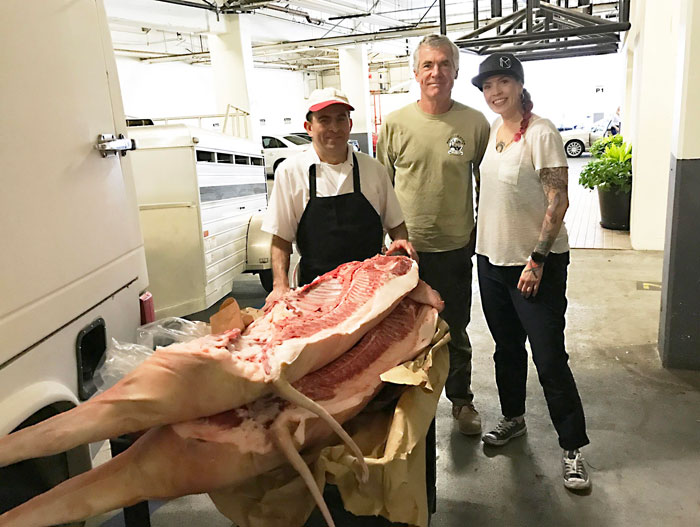 View more on our Instagram page
View more on our Instagram page
The pig in Hungarian History — By Wilhelm W. Kohl
An exciting story of the survival of a nation & the glory days of the Mangalitsa
The current pig industry in Hungary was probably started by the Transylvanian Saxons, German settlers encouraged by King Geza II, of Hungary (1141-1162) to colonize and defend the southeastern frontier of the Kingdom of Hungary. From the 12th century onward until the end of the 13th century this migration of Germans…
(click here to download/read the rest of the story)
Aly’s Restaurant: Reserve the last available seats for L&L wine maker dinner


2013 Lucas & Lewellen Late Harvest Viognier
Week of Sept 29th – Oct 3rd
Appetizers
Aly’s Salad 14
Mixed Greens, Belgian Endive, Avocado, Orange,
Candied Pecans & Citrus Dressing
Bosc Pear with Manchego Cheese 15
Arugula, Pear, Honey Pearls & Aged Balsamic Vinegar
Fish Tacos 14
Salsa, Queso Fresco, Avocado & Grilled Lime
Dungeness Crab Trio 16
Cake, Enchilada, Bisque
Maine Lobster Macaroni & Cheese 18
White Truffle Butter & Homemade Croutons
Tomato Lobster Bisque Soup 14
Truffle Oil & Butternut Squash Chips
Main Course
Diver Sea Scallops with Garlic Mashed Potato 38
Asparagus, Pine Nut Butter & Tomato Lobster Sauce
Alaskan Halibut 35
Curry Sauce, Baby Bok Choy, Jasmine Rice & Soy Pearls
Wild King Salmon 33
Local Organic Broccoli, Cauliflower & Roasted Bell Pepper Sauce
Duck Breast 36
Cherry Compote, Forbidden Wild Rice & Port Wine Sauce
Filet Mignon 45
Yukon Potato Cheddar Cheese Fondue,
Cabernet Sauce & Sweet Onion Rings
Risotto 29
Shitake Mushrooms, Spinach & Manchebo Cheese Foam
Chef’s Tasting Menu
Grilled Maine Lobster Tail
Asian Cabbage Salad,
Edible Sea Sand
Gérard Bertrand – Brut Rosé 2013
Warm Smoked Sea Scallops
Cornbread Pudding, Papaya Salsa, Almond Fennel Crumbs
Gainey – Chardonnay 2013
Local Mangalitsa Collar Steak
Shallots, Shiitake Mushroom, Sherry Salsa
Vina Robles – Cabernet Sauvignon 2013
Crêpe Basket
With Fresh Fruit & Homemade Apricot Ice Cream
Dessert Wine
Menu 60.00 with Wine Pairing 80.00
Additional Appetizer 10.00- Additional Wine Pairing 7.00
Our Menu is subject to frequent changes to ensure
we can provide you with the freshest ingredients
Winfield Farm Summer Update
Summertime and the Living is Hectic
Our spring crop of Manga piglets is at the marauding age – rambunctious escapees who slip through fences at will and nip at Bruce’s heels on his feeding rounds, or shoot through his legs to get first crack at the barley bowls. We’re also making regular overnight trips to the USDA harvest facility in Fresno, a four hour midnight drive, now that orders are increasing (and we’ve found a reliable piggysitter). So “R & R” is a scarce commodity these days as summer is upon us.
But we’re not complaining! We’re delighted that more and more foodies are discovering the magical flavor of Winfield Mangalitsa. With grateful thanks to Edible Santa Barbara magazine, coordinators of the Tastes of Communities event at Santa Barbara’s exclusive Bacara Resort in April (see our Spring Update, part 3), we connected with Executive Chef Jeffrey O’Brien. Chef Jeff now features Winfield Mangalitsa pork on the menu of the Bacara’s Bistro restaurant. Succulent Winfield Mangalitsa loin roasts are popular with Bacara guests as well. Chef Jeff also served Winfield Mangalitsa belly in his Korean BLT sliders at Fiesta Ranchero, a special event in Goleta in June (to raving acclaim, we heard).
Edible also introduced us to another great customer, Barbareño in Santa Barbara. Executive Chef Julian Martinez now features Winfield Mangalitsa in the restaurant’s acclaimed Plate of Pork.
When Chef Julian informed us that Barbareño was hosting the Edible summer issue release party and invited us to participate, the event seemed a perfect fit — a great way to celebrate the magazine and promote our Mangalitsa simultaneously at one of our favorite restaurants. (Chef Julian creates amazing pork dishes with our heritage wooly pigs — magical flavor indeed!)
Partygoers lined up more than a hundred strong outside Barbareno to sample Chef Julian’s Cuban-inspired Mangalitsa pork sandies – melt in your mouth delicious!
Meanwhile, Winfield Farm, in partnership with Larder Meat Co. (owners Grace and her husband Chef Jensen Lorenzen are Bruce’s niece and nephew), offered tasty bites featuring Winfield pork meatballs skewered with grapes and dipped in Chef Jensen’s special sauce, and guanciale cured for us by Alle Pia skewered with pineapple chunks, all grilled on Jensen’s yakitori grill.
The party at Barbareño was a grand success in multiple ways: Edible Santa Barbara magazine’s summer issue received a royal sendoff, Barbareño gained even more acclaim as one of Santa Barbara’s most innovative restaurants, and Winfield Farm helped spread the word about The Larder Meat Company’s new Larder Club — a CSA-style monthly meat box that features premium quality beef, chicken and pork from local sustainable family farmers. Of course the pork in the box is Mangalitsa from Winfield Farm.
All in the Family
We’re delighted to participate in the Larder Club, the creation of Chef Jensen and Grace, whose venture has struck a chord in the local community, as memberships have soared in their first month of operation from 32 boxes to 70 and growing. Each membership is called a “share”.
Here are pertinent details from the Larder Co. website:
WHAT’S IN THE BOX?
[Members] will receive a 12-13 pound “share” of locally sourced and sustainably raised meats. This will typically include the following: 8 lbs of Beef (mixture of steaks, roasts, and ground), 1 whole chicken (3-3.5 lbs average), 1.5 lbs of Pork (1lb of ground and a half pound of Bacon), a recipe card with preparation tips and at least one “special item of the month” like brine for the chicken, steak rub, or my favorite baste sauce. This share is intended to be a one-month supply of locally raised meat for a family size of 2-4 people.
WHY IS IT CALLED A SHARE?
As a member of the Larder Meat Co. your money is going directly to local Ranchers to purchase whole animals. After processing at a USDA Certified butcher, each animal is divided equally amongst the members. Think of it as purchasing stock in a publicly traded company, but with much tastier options and a better ROI – feeding your family in an environmentally responsible manner and supporting our Local Food Economy!
Here’s how it works:
1. WE FIND THE FARMS THAT DO IT RIGHT
2. YOU PLACE YOUR ORDER ONLINE (WE CURRENTLY HAVE ONE OPTION, $199 FOR A 12-13 LB BOX)
3. WE DELIVER A CURATED BOX OF LOCALLY RAISED MEATS TO YOUR DOOR ONCE A MONTH
4. YOU CHECK ‘MEAT’ OFF OF YOUR GROCERY LIST AND COOK DELICIOUS MEALS THAT YOU CAN FEEL GOOD ABOUT!
Check out the Larder Meat Co. website for more information.
Here are some scenes from Barbareno’s Edible Santa Barbara summer release event.
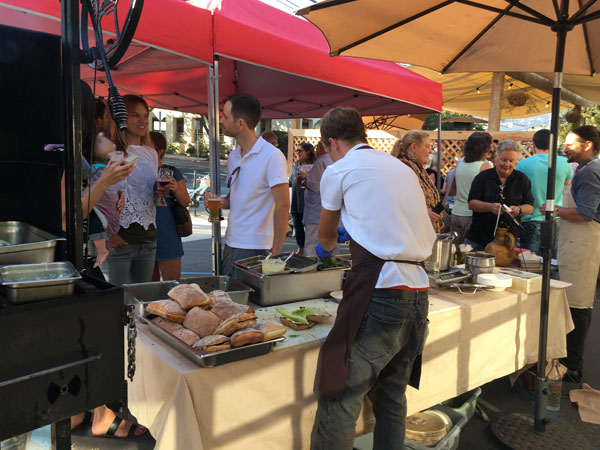 Barbareno served Cuban pork sandies featuring Winfield Mangalitsa at the Edible SB summer release party
Barbareno served Cuban pork sandies featuring Winfield Mangalitsa at the Edible SB summer release party

Bruce Steele explained Winfield Farm’s sustainable solar-powered farm practices, including natural GMO-free feed, to produce top quality Mangalitsa pork

A happy guest enjoys a taste of magic — Mangalitsa meatball with grapes

Grace Lorenzen (on right), co-owner of Larder Meat Co., explains how the Larder Club works – a monthly meat box delivered to the community and featuring sustainably raised local beef, chicken and Winfield Farm Mangalitsa pork

A NEW PIG IN TOWN
The true story of how Mangalitsas first came to the U.S…. Winfield Farm pigs are descendants from this original herd.
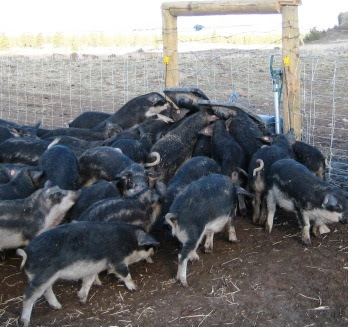
A NEW PIG IN TOWN – story and photo by Heidi Broadhead
Heath Putnam just wanted some tasty pork. And he figured he was not alone.
“There are certain things that people pay money for willingly. They hit people on a really, really low level. Good food is something like that. Porn is something like that. Prostitution. Drugs,” he said. “When I tasted the Mangalitsa, I knew it was one of those things.”
Mangalitsa pigs, also known as Wollschwein or Wooly pigs (the name that Putnam chose for his business), are native to Hungary. This lard-type breed of pig (i.e., valued for its natural marbling as opposed to American pigs that are bred and fed to be lean) was not available in the United States until last fall, when Putnam imported them from Austria.
Putnam first tasted a Mangalitsa sausage when he was working in Europe. He and his wife and business partner, Zuzana, were repeatedly disappointed by the quality of meat here. They decided to import a small herd of Swallow-Bellied Mangalitsa, a close kin to the wild boar, because they thought this nomadic, foraging pig would be the European breed most likely to thrive in the cold, dry Palouse region of Washington State.
Putnam had never been a farmer, and he had no interest in becoming one. He found a local rancher, Gary Angell of the Rocky Ridge Ranch 30 miles west of Spokane, to raise the pigs. Angell’s area of expertise was forage-raised beef. When he told neighboring farmers about the project, he mostly heard responses like “You’re crazy” and “They’re all gonna die out here.”
Putnam planned to go to Austria with Angell to select and purchase the Mangalitsa pigs. Due to some last-minute health problems, Angell had to stay behind and Putnam went ahead on his own, visiting nine farms and amassing as much information as he could for Angell on how to properly breed, raise and finish the pigs.
He joined the Mangalitsa Breeder’s Association, a group dedicated to reintroducing the breed to Austria (it disappeared temporarily in the 1970s) and to maintaining the quality of the breed. He studied charcuterie with a butcher and got whole-hog tips from a renowned Austrian chef.
“He went over to buy nine pigs,” Angell said. Putnam instead chose to import 29 hogs—two boars and 27 sows, the maximum that could fit in one cargo hold. This allowed him to maximize genetic diversity with three to four lines.
Challenges ensued. After being quarantined in Austria from March to May 2007, Putnam’s Mangalitsas were transported to a quarantine center in upstate New York. From May 12 to August 12, the pigs underwent various tests, delaying their stay long enough for 65 piglets to be born in quarantine (and accruing $1,000 per pig in boarding costs). Wooly Pigs lost 10 piglets on the truck between New York and Spokane. At the ranch, the piglets had a negative reaction to a vet-recommended vaccination and they lost one more.
In November, they slaughtered three piglets for samples and to fill their first restaurant order—from the French Laundry—which revealed the lack of USDA-approved processing facilities in their region that could deal with their special slaughtering needs—like keeping the pigs in a low-stress environment leading up to the slaughter, which is important to Wooly Pigs’ philosophy of humane farming and something that Putnam maintains is crucial to preserving the meat’s flavor.
Tasting the Meat
I visited Rocky Ridge Ranch last November. We sat around the kitchen table—Putnam, Angell, Angell’s wife So and me.
“We are the first four people to try the North American Mangalitsa,” Putnam said as he spooned the three-month-old roasted piglet meat onto our plates. “Not like anything you’ve ever tasted, right?”
The dark meat was so moist it crumbled as soon as the fork touched it. We ate the jowls. We chewed the meat off tiny ribs. We ate soft fat that tasted more like cream or butter. We each had different ways of describing what the meat tasted like, but we all agreed on one thing: This does not taste like pork.
Eating a Mangalitsa is like eating a pig from a hundred years ago. It’s a completely different kind of animal. Since the middle of the 20th century, U.S. pork demand has gone the way of lean—lard was replaced by vegetable oils for cooking, and people began to prefer meatier cuts. Pigs were bred to be lean and to grow very quickly.
Old-style Mangalitsas (what Putnam calls on his website “unimproved breeds”), on the other hand, come from a line that was primarily raised in Hungary, Mangalitsas cross-bred with Serbian wild boars.
“They’ve been behind the Iron Curtain since the ’50s,” said Angell. “Maybe that has something to do with it.”
One look at these near-wild beasts will tell you that this is no ordinary pig. The sows have high, curved backs with coarse gray, black and brown hair on their backs and falling over their eyes. They lift and throw giant rocks with their mud-covered snouts. A couple of them nibbled at the back of my leg, which made me a little nervous after hearing that #5 had recently bit Angell, leaving a pretty nasty bruise. Apparently, as long as I wasn’t a coyote or some other predator trying to get to a piglet, I was safe. (Mangalitsas are very protective mothers.)
And most of the pigs we eat in Washington State come from somewhere else. Although exact consumption data is not available, the Washington Department of Agriculture estimates that 90 to 95 percent of pork consumed here is from out of state, primarily from large producers in the Midwest. (As a comparison: As of December 1, 2007, Washington had 29,000 total hogs and pigs. Iowa, by contrast, had 18.2 million.) Input methods vary, but the predominant feed for pen-raised pigs in the United States is corn and soybean meal.
Mangalitsas are self-sufficient and forage in social groups without needing to be fed or moved from one spot to another, so they are perfectly at home in their 30-acre field. Wooly Pigs raises all their pigs (Mangalitsas and Berkshires) on protein-rich crops in the summer. In the fall and winter, they forage on dry oats, peas, sunflowers, turnips, weeds and grasses. They are finished on hay (alfalfa-barley) and a mix of local grains.
“The quality of fat is amazing,” the Herbfarm’s Executive Chef Keith Luce said of Wooly Pigs’ Berkshires, which are raised on the same diet as the Mangalitsas. “It’s embarrassing, actually. We were taking fat and spreading it on bread like butter.”
Heidi Broadhead is a regular contributor to Amazon’s books blog, Omnivoracious, and is currently writing monster descriptions for the next edition of Beasts! for Fantagraphic Books.
Mangalitsa Lardo
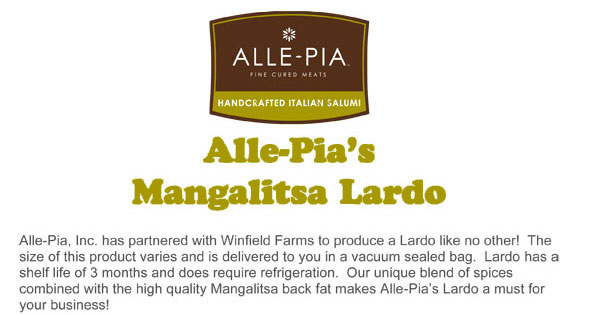 Call Alle-Pia, Inc. at (805) 461-6800 or email at: info@allepiasalumi.com for pricing.
Call Alle-Pia, Inc. at (805) 461-6800 or email at: info@allepiasalumi.com for pricing.
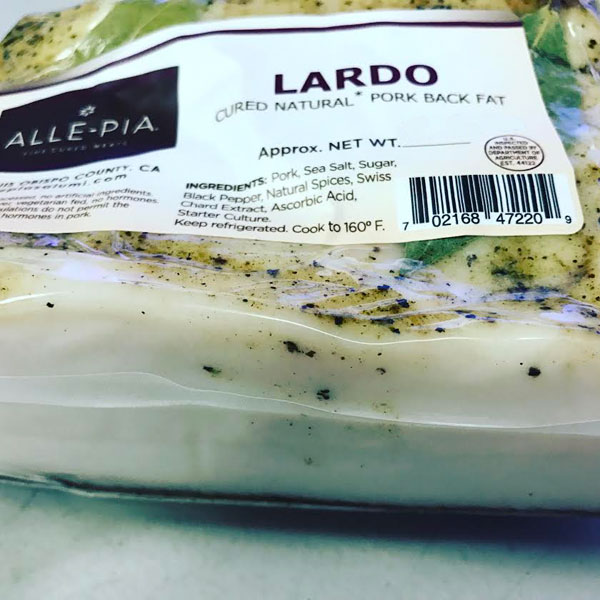
WINFIELD FARM SPRING UPDATE PART 3
Winfield Farm Mangalitsa Wowed the Crowd at the 3rd Annual Santa Barbara Food and Wine Neighborhood Market Tour at the Bacara Resort
Capping our spring fling promoting Winfield Farm Mangalitsa pork, we were honored and delighted to represent the Santa Ynez Valley farm community, among Santa Barbara County’s most talked about culinary neighborhoods, all gathered on a sunny Sunday in April in the beautiful surroundings of the Bacara Resort’s Courtyard, to celebrate and benefit The Julia Child Foundation.
The Food and Wine Neighborhood Market Tour at the Bacara, a world-class resort overlooking the Pacific Ocean near Santa Barbara, featured tastings by dozens of local and nationally-acclaimed chefs, artisans, winemakers and farmers. Our Winfield Farm table served up Mangalitsa meatballs dipped in secret sauce created by Chef extraordinaire Jensen Lorenzen (Bruce’s nephew), which he fired on his yakitori grill. Bruce and I slathered artisan crackers with Mangalitsa Nduja – a new Winfield Farm product created by our salumi partner Alle Pia from cured Mangalitsa salami Barolo, ground and infused with Palmina Nebbiolo wine, with sun dried tomatoes, garlic and seasonings. Nduja’s texture is reminiscent of tomato paste, but the flavor is out-of-this-world piquant!! Alle Pia partner Alex Pellini also joined us and offered their hand-crafted salami Barolo and Tartufo.
The event was patterned after a farmers’ market, hours 11 AM to 2 PM. Throngs of people table hopped, sampling food and drink from diverse communities including Santa Barbara’s eclectic Funk Zone, Old Town Goleta, the Arts District, Los Alamos and Lompoc, as well as SY Valley.
Food and wine presentation tables ringed the courtyard, while dozens of cloth-draped tea tables scattered about offered tasters a place to sit and enjoy the food and drink.
Event presenters all committed to providing 500 servings – and between the meatballs, Nduja and salami we must have at least doubled that quantity. It seemed that as soon as Chef Jensen set out a tray of Manga meatballs, they vaporized — and the same with the Nduja and salami. Then we noticed the same people coming back again and again … a group of people sitting at the tea table nearest our stand had become fast fans of Mangalitsa pork!
The crowd came early and many lingered until the last taste and sip were stowed away. The Bacara’s Neighborhood Market Tour was a great way to spend a sunny Sunday — educating friends and neighbors about the magical flavor of Mangalitsa pork. Many stopped by to thank us for sharing, and to compliment Winfield Mangalitsa as the best bite of the event. The Chefs at the Bacara also took note. Winfield Mangalitsa pork is now featured on the Bacara Bistro’s breakfast menu! And the Chef told us they’re opening a new restaurant soon, and expressed interest in Winfield Mangalitsa chops… We’re excited about that prospect!
Photo gallery:
 Chef Jensen, Bruce and Alex lay out Winfield Mangalitsa tasting at the Bacara
Chef Jensen, Bruce and Alex lay out Winfield Mangalitsa tasting at the Bacara
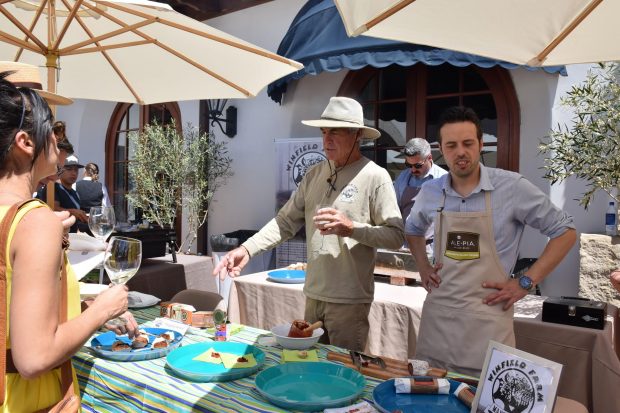 Event goers crowd the Winfield Farm table at the Bacara Taste of the Communities Event
Event goers crowd the Winfield Farm table at the Bacara Taste of the Communities Event
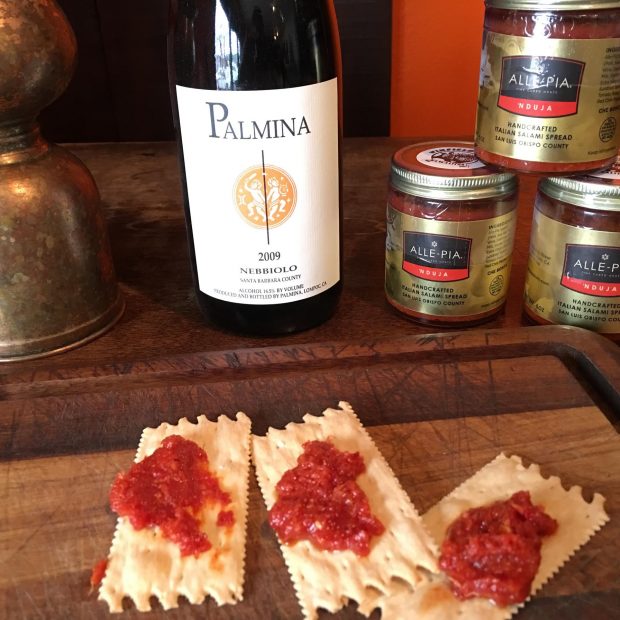 New product: Mangalitsa Nduja infused with Palmina Nebbiolo
New product: Mangalitsa Nduja infused with Palmina Nebbiolo


